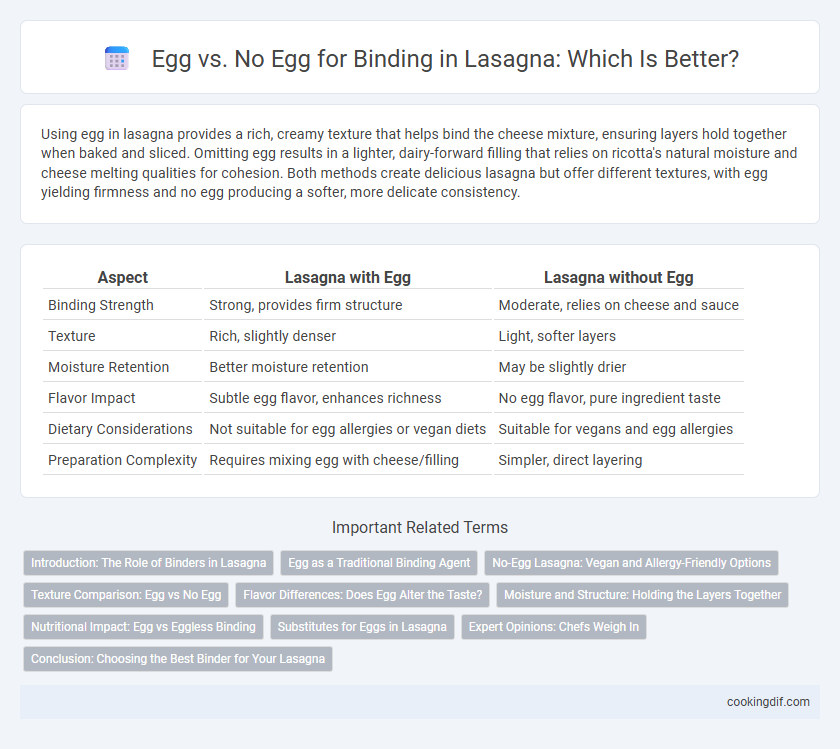Using egg in lasagna provides a rich, creamy texture that helps bind the cheese mixture, ensuring layers hold together when baked and sliced. Omitting egg results in a lighter, dairy-forward filling that relies on ricotta's natural moisture and cheese melting qualities for cohesion. Both methods create delicious lasagna but offer different textures, with egg yielding firmness and no egg producing a softer, more delicate consistency.
Table of Comparison
| Aspect | Lasagna with Egg | Lasagna without Egg |
|---|---|---|
| Binding Strength | Strong, provides firm structure | Moderate, relies on cheese and sauce |
| Texture | Rich, slightly denser | Light, softer layers |
| Moisture Retention | Better moisture retention | May be slightly drier |
| Flavor Impact | Subtle egg flavor, enhances richness | No egg flavor, pure ingredient taste |
| Dietary Considerations | Not suitable for egg allergies or vegan diets | Suitable for vegans and egg allergies |
| Preparation Complexity | Requires mixing egg with cheese/filling | Simpler, direct layering |
Introduction: The Role of Binders in Lasagna
Eggs serve as a traditional binder in lasagna, providing structure and helping the layers adhere during baking for a firm texture. Recipes without eggs often rely on alternatives like ricotta cheese or bechamel sauce, which offer moisture and cohesion while maintaining tenderness. The choice between egg and no egg influences the lasagna's consistency, with egg-based versions yielding a denser slice versus the softer, creamier outcome of egg-free options.
Egg as a Traditional Binding Agent
Egg serves as a traditional binding agent in lasagna, contributing to the structure and moisture retention of the filling, especially in ricotta-based mixtures. Its protein content helps bind ingredients together during baking, ensuring the layers hold shape without becoming overly watery or crumbly. Using egg enhances the texture and stability of lasagna, making it a preferred choice for classic recipes.
No-Egg Lasagna: Vegan and Allergy-Friendly Options
No-egg lasagna offers a vegan and allergy-friendly alternative by using ingredients like tofu, blended silken beans, or vegetable purees to achieve a creamy, cohesive texture. These substitutes maintain the dish's traditional structure without compromising flavor or nutrition, making lasagna accessible to those with egg allergies or dietary restrictions. Plant-based binders enhance moisture retention and promote a tender layer formation, ensuring a satisfying, egg-free meal option.
Texture Comparison: Egg vs No Egg
Egg in lasagna enhances the texture by adding a creamy, rich binding that holds layers firmly and prevents crumbling during slicing. Without egg, the texture tends to be lighter and less dense, resulting in a more delicate structure that can sometimes fall apart more easily. The presence of egg creates a firmer, more cohesive bite, while no egg offers a softer, less compact texture.
Flavor Differences: Does Egg Alter the Taste?
Using egg as a binding agent in lasagna subtly enhances the dish by adding a richer, creamier texture and a slightly more savory flavor profile. Lasagna prepared without egg tends to have a lighter, more straightforward taste, allowing the sauces and cheeses to shine without the additional eggy undertone. Ultimately, the presence of egg influences the mouthfeel and flavor depth, with egg-based layers delivering a more cohesive, custard-like consistency.
Moisture and Structure: Holding the Layers Together
Eggs provide natural proteins that improve the structure and moisture retention in lasagna, ensuring the layers hold together firmly without becoming dry. Using no egg often requires alternative binders like ricotta cheese or bechamel sauce to maintain moisture and prevent the dish from falling apart. Proper moisture balance is essential for lasagna, with eggs contributing to a cohesive texture that combines firmness and tenderness between layers.
Nutritional Impact: Egg vs Eggless Binding
Egg-based binding in lasagna significantly boosts protein content, essential amino acids, and certain vitamins like B12, enhancing its nutritional profile. Eggless lasagna relies on alternatives such as ricotta, tofu, or vegetable purees, which offer lower cholesterol and saturated fat, making it suitable for vegan or cholesterol-conscious diets. The choice impacts calorie density and macronutrient balance, with egg inclusion increasing protein but also cholesterol, and eggless options favoring fiber and plant-based nutrients.
Substitutes for Eggs in Lasagna
Eggs are traditionally used in lasagna to bind the cheese and pasta layers, providing structure and moisture retention. Popular substitutes for eggs include ricotta cheese, blended tofu, or vegan mayonnaise, which mimic the binding properties while catering to dietary restrictions. These alternatives maintain the creamy texture and cohesion without compromising the classic lasagna flavor or consistency.
Expert Opinions: Chefs Weigh In
Chefs often debate the use of eggs as a binding agent in lasagna, with many endorsing eggs to enhance structure and creaminess in ricotta layers, while others argue that omitting eggs results in a lighter, more delicate texture. Expert opinions highlight that traditional Italian recipes frequently exclude eggs, relying on cheese and bechamel for cohesion, whereas American adaptations commonly incorporate eggs for firmer slices. The choice ultimately depends on desired texture and authenticity, with culinary professionals recommending trials to balance moisture and binding according to specific lasagna styles.
Conclusion: Choosing the Best Binder for Your Lasagna
Egg provides a rich, creamy texture that helps bind the layers of lasagna firmly, enhancing structural integrity during baking. Alternatives like ricotta cheese, bechamel sauce, or plant-based binders offer moisture and cohesion without altering flavor significantly, catering to dietary restrictions or preferences. Selecting the best binder depends on desired texture, dietary needs, and flavor profile, with eggs ideal for traditional recipes and non-egg options suitable for lighter or vegan variations.
Egg vs No egg for binding Infographic

 cookingdif.com
cookingdif.com